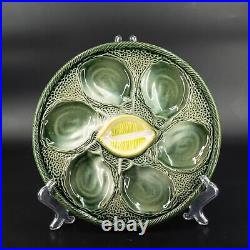
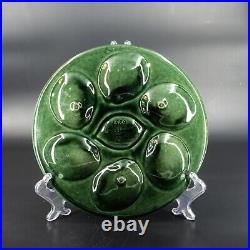

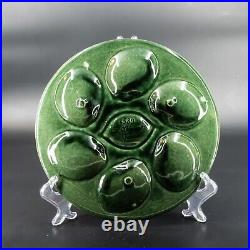
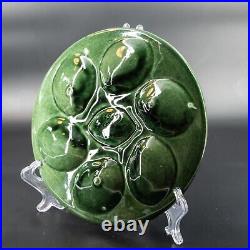
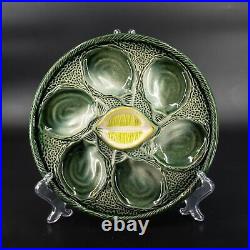
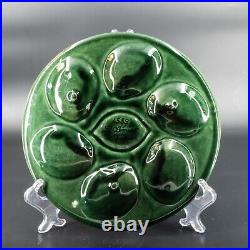
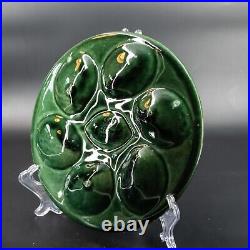

Vintage French Majolica Oyster Plate by St Clement, Signed, in green and yellow colors, circa 1950s. Vintage Oyster Plate made by St Clement. French Majolica of mid 20. Six oyster wells shaped in shells form are surrounded by beautiful embossed seaweeds ornament and a center well for lemon in the shape of half lemon. Colors are bright and juicy, the glaze is shiny. 4589 St Clement France’. The faience factory of Saint-Clement, 12 kms from Lunéville, was established in 1758 by Jacques Chambrette, who already owned another one in Lunéville. With this second factory he aimed at the higher segment of the market with prestigious objects. The factory received because of this a label as Royal Supplier for Marie-Antoinette’s Trianon. After Jacques died in 1758, his son Gabriel became the new owner. Between 1759 and 1763 the factory was managed by Charles Loyal, Jacques Chambrette’s son-in-law, Paul Louis Cyfflé and the architect Richard Mique, who owned half the factory in 1786. This factory was owned by several shareholders. Amongst them was the Thomas family, who cleverly bought up all the shares and became the sole owners in 1863. W ho already owned the earthenware factory of Lunéville. Under their management the company was considerably expanded in the last quarter of the 19th century. In 1907, the workshop where the ovens were was partly rebuilt by the company Masson from Lunéville. In 1922 Edouard Fenal, who already owned the earthenware factory in Badonviller, became the new owner of the Saint-Clément and Lunéville factories. He established the “Atelier d’Art de Lunéville”, where Lachenal, Bussière and Majorelle worked. The sculptors Charles Lemanceau and Geo Condé joined the ceramists Joseph and Pierre Mougin and they created Art Nouveau and Art Déco earthenware. At the same time traditional production was continued. Nowadays Saint-Clément is the only earthenware factory that is still active. Even though the technique of hand-painted decorations no longer exist, the successful decorations are still applied. The factory is now part of the Sarreguemines group and employes 130 persons. Since 1968 in this factory Lunéville earthenware has been created under the name K. In the 18th century Saint-Clément produced domestic objects of ordinary earthenware, luxurious objects and decorative objects of fine earthenware (so-called “terre de pipe”). Between the first quarter of the 19th century and 1892 both current utensils of ordinary earthenware and fine earthenware are produced and decorative objects of grand and petit feu (Emile Gallé). In the second half of the 19th century the factory reproduced Louis XIV objects, among them objects with very unnatural forms, where they attempted to imitate the multicoloured decorations of Strasbourg faience. After 1920 the production consisted of dinnerware of fine earthenware (often with old decorations) and decorative objects (animals) in craquelé earthenware (around 1925, 1930). The production of barbotine is continued until 1930. Diameter of the plate. 24 cm/ 9.05. Weight 613 grams / 1.35 lbs. No chips, no cracks or repairs. Please see the photos for details. Every piece will be carefully wrapped in professional air bubble plastic, paper wrap and placed in a thick cardboard box. We are a multinational couple living in France. We are passionated by the beauty and elegance of French savoir-fair in decorative crafts and on our page we will offer interesting finds. We speak English, French, Polish and Russian and we believe that through communication we will always find a way out.

